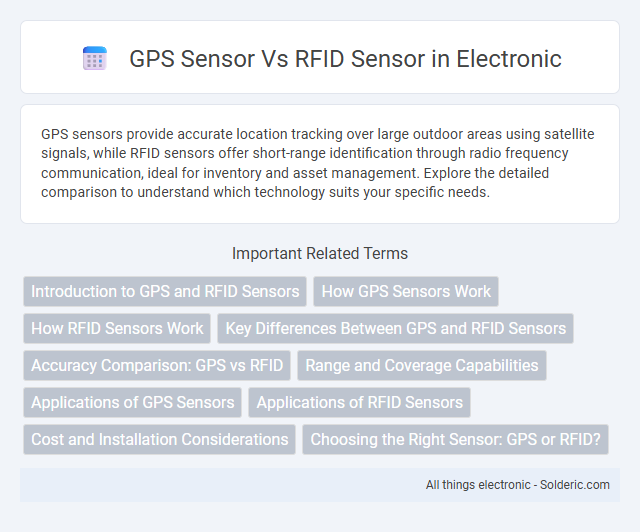GPS sensors provide accurate location tracking over large outdoor areas using satellite signals, while RFID sensors offer short-range identification through radio frequency communication, ideal for inventory and asset management. Explore the detailed comparison to understand which technology suits your specific needs.
Comparison Table
| Feature | GPS Sensor | RFID Sensor |
|---|---|---|
| Purpose | Global positioning and navigation | Identification and tracking of objects/items |
| Technology | Satellite-based radio signals | Radio frequency identification via tags and readers |
| Range | Worldwide coverage (unlimited range) | Short to medium range (a few centimeters to ~100 meters) |
| Accuracy | 3-10 meters (consumer-grade) | Millimeter to meter level depending on system |
| Power Requirement | Active device, requires power | Passive tags can be battery-free; readers require power |
| Use Cases | Vehicle tracking, navigation, mapping | Inventory management, access control, asset tracking |
| Cost | Moderate, higher due to satellite and receiver tech | Low to moderate, inexpensive tags with basic readers |
| Environmental Constraints | Requires open sky view; affected by buildings/obstacles | Works indoors and outdoors; limited by metal/liquid interference |
Introduction to GPS and RFID Sensors
GPS sensors utilize satellite signals to determine precise geographic location by triangulating multiple satellites, making them essential for navigation and tracking applications worldwide. RFID sensors rely on radio frequency identification technology, using electromagnetic fields to automatically identify and track tags attached to objects, commonly employed in inventory management and access control. Both sensors enable real-time data collection but differ significantly in range, accuracy, and use cases depending on the environment and application requirements.
How GPS Sensors Work
GPS sensors work by receiving signals from a network of satellites orbiting the Earth, allowing your device to determine its precise location through trilateration. These sensors calculate the distance to multiple satellites by measuring the time it takes for the satellite signals to reach the receiver. Unlike RFID sensors that rely on proximity and radio frequency tags, GPS sensors provide continuous, global positioning data ideal for navigation and tracking purposes.
How RFID Sensors Work
RFID sensors operate by using radio waves to communicate between a reader and a tag attached to an object, enabling automatic identification and tracking without direct line of sight. The RFID tag contains a microchip and antenna, which respond to the reader's signals by transmitting stored data, allowing for real-time monitoring and inventory management. Your system can benefit from the passive or active nature of RFID tags, providing flexible solutions for asset tracking, access control, and supply chain efficiency.
Key Differences Between GPS and RFID Sensors
GPS sensors provide real-time global positioning by receiving satellite signals to determine precise location coordinates, while RFID sensors use radio frequency waves to identify and track objects within a limited range. GPS excels in outdoor navigation and large-area tracking, whereas RFID is ideal for short-range identification, inventory management, and access control. The main difference lies in GPS offering continuous location data with global coverage compared to RFID's localized, tag-based object recognition system.
Accuracy Comparison: GPS vs RFID
GPS sensors provide location accuracy typically within 3 to 10 meters outdoors, leveraging satellite signals for geospatial positioning. RFID sensors offer high precision in proximity detection, often within centimeters, but require close-range tag interaction and are limited to localized environments. While GPS excels in wide-area outdoor tracking, RFID outperforms in accuracy for specific object identification and indoor asset tracking.
Range and Coverage Capabilities
GPS sensors provide extensive range and global coverage by communicating with satellites, enabling precise location tracking anywhere on Earth. RFID sensors operate within limited ranges, typically a few centimeters to several meters, depending on the type (passive, active, or semi-active), making them ideal for close-proximity identification and tracking. While GPS excels in wide-area navigation, RFID is optimized for local asset management and access control within confined environments.
Applications of GPS Sensors
GPS sensors enable precise geolocation tracking essential for navigation, fleet management, and outdoor recreational activities. They are widely used in automotive systems for route optimization, in agriculture for field mapping and crop monitoring, and in emergency services for real-time location tracking. GPS technology also supports asset tracking, personal fitness devices, and location-based services in smartphones, enhancing situational awareness and operational efficiency.
Applications of RFID Sensors
RFID sensors are widely used for inventory management, asset tracking, and access control in industries like retail, healthcare, and logistics. These sensors enable real-time identification and monitoring of objects without line-of-sight, increasing efficiency and reducing manual errors. Unlike GPS sensors, RFID operates effectively indoors and in environments with limited satellite connectivity.
Cost and Installation Considerations
GPS sensors generally incur higher costs due to advanced satellite communication components and require clear sky visibility for optimal installation. RFID sensors offer a more cost-effective solution with simpler, quick installation processes since they operate via radio frequency, but they need proximity to readers for accurate data capture. Choosing between GPS and RFID depends on budget constraints and the desired range and environment of deployment.
Choosing the Right Sensor: GPS or RFID?
Selecting the appropriate sensor depends on the application's requirements for range, accuracy, and environment. GPS sensors provide global location tracking with high accuracy outdoors but struggle indoors or in dense urban areas where satellite signals are weak. RFID sensors excel in short-range identification and tracking within controlled environments, offering cost-effective solutions for inventory management and asset tracking without relying on satellite connectivity.
GPS sensor vs RFID sensor Infographic

 solderic.com
solderic.com